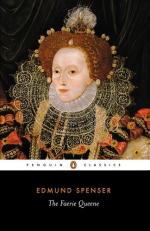425. TO HER LAST DECAY, to her utter ruin.
426. Spenser leaves the fight between Sansloy and Sir Satyrane unfinished. Both warriors appear in later books of the Faerie Queene.
QUESTIONS AND TOPICS
(Canto VI)
1. Who rescued Una from Sansloy? 2. How does Una repay their kindness? 3. How was she treated by them? 4. Explain the references to the various classes of nymphs. 5. Look up the classical references in xvi and xviii. 6. Why is Una described as “luckelesse lucky”? 7. What customs of the early Christians are referred to in xix? 8. What does Sir Satyrane symbolize in the allegory? 9. What was his character and education? 10. Note the Elizabethan conception of the goddess Fortune in xxxi. 11. Did Una act ungratefully in leaving the Satyrs as she did? 12. Who is the weary wight in xxxiv? 13. What news of St. George did he give? Was it true? 14. Who is the Paynim mentioned in xl? 15. Note Euphuistic antithesis in xlii. 16. Explain the figures in iv, vi, x, xliv. 17. Paraphrase ll. 289, 296. 18. Find Latinisms in xxv; xxvi; xxviii; xxxi; and xxxvii. 19. Describe the fight at the end of the Canto.
CANTO VII
I. The Plot: (Continuation of Canto V). Duessa pursues the Redcross Knight, and overtakes him sitting by an enchanted fountain, weary and disarmed. He is beguiled into drinking from the fountain, and is quickly deprived of strength. In this unnerved and unarmed condition he is suddenly set upon by the giant Orgoglio. After a hopeless struggle he is struck down by the giant’s club and is thrust into a dungeon. Una is informed by the dwarf of the Knight’s misfortune and is prostrated with grief. Meeting Prince Arthur, she is persuaded to tell her story and receives promise of his assistance.
II. The Allegory: 1. The Christian soldier, beguiled by Falsehood, doffs the armor of God, and indulges in sinful pleasures, and loses his purity. He then quickly falls into the power of Carnal Pride, or the brutal tyranny of False Religion (Orgoglio). He can then be restored only by an appeal to the Highest Honor or Magnificence (Prince Arthur) through the good offices of Truth and Common Sense.
2. In the reaction from the Reformation, Protestant England by dallying with Romanism (Duessa, Mary Queen of Scots) falls under the tyrannic power of the Pope (Orgoglio), with whom Catholic England was coquetting. At this juncture National Honor and Consciousness comes to the relief of Protestantism. There is personal compliment to either Lord Leicester or Sir Philip Sidney.
19. HE FEEDES UPON, he enjoys. A Latinism: cf. Vergil’s Aeneid, iii.
37. PHOEBE, a surname of Diana, or Artemis, the goddess of the moon.
45. Spenser probably takes the suggestion from the fountain in the gardens of Armida in Tasso’s Jerusalem Delivered, xiv, 74. Cf. also the fountain of Salmacis in Ovid’s Metamorphoses, xv, 819 seq.




